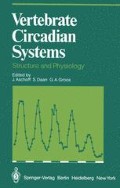Abstract
It is only within the last 15 years that a few favorable experimental situations have been identified that have made it possible to study the physiology of circadian systems in some vertebrates (Aschoff 1981). Given the complexity of the systems under study, the long time constants of experimentation, and the relatively small number of scientists engaged in the work, it is not surprising that I must address the search for principles rather than the principles themselves. Insofar as documented principles exist, they are disturbingly vague. However, in discussing them it becomes clear that at least we know where we should be looking further. A few principles, proto-principles and pseudoprinciples are discussed below.
Access this chapter
Tax calculation will be finalised at checkout
Purchases are for personal use only
Preview
Unable to display preview. Download preview PDF.
References
Aschoff J (ed) (1981) Handbook of behavioral neurobiology, 4. Biological rhythms. Plenum Press, New York London
Blanks JC, Adinolfi AM, Lolley RN (1974) Photoreceptor degeneration and synaptogenesis in retinal-degenerative (rd) mice. J Comp Neurol 156:95–106
Banerjee S, Margulis L (1973) Mitotic arrest by melatonin. Exp Cell Res 78:314–318
Cardinali DP, Freire F (1975) Melatonin effects on brain. Interactions with microtubule protein, inhibition of fast axoplasmic flow and induction of crystalloid and tubular formations in the hypothalamus. Molec and Cell Endocrinol 2:317–330
Carter-Dawson LD, LaVail MM, Sidman RL (1978) Differential effect of the rd mutation on rods and cones in the mouse retina. Invest Ophthalmol Vis Sci 17:489–498
Daan S, Pittendrigh CS (1976) A functional analysis of circadian pacemakers in nocturnal rodents. II. The variability of phase response curves. J Comp Physiol 106:253–266
Ebihara S, Tsuji K (1980) Entrainment of the circadian activity rhythm to the light cycle: Effective light intensity for a Zeitgeber in the retinal degenerate C3H mouse and the normal C57BL mouse. Physiol Behav 24:523–527
Gwinner E (1978) Effects of pinealectomy on circadian locomotor activity rhythms in European starlings, Sturnus vulgaris, J Comp Physiol 126:123–129
Levinson G, Burnside B (1981) Circadian rhythms in teleost retinomotor movements. Invest Ophthalmol Vis Sci 20:294–302
McMillan JP, Keatts HC, Menaker M (1975) On the role of eyes and brain phtoreceptors in the sparrow: Arrhythmicity in constant light J Comp Physiol 102:263–268
Menaker M (1968) Extraretinal light perception in the sparrow. I. Entrainment of the biological clock. Proc Nat Acad Sci USA 59:414–421
Moore RY (1979) The retinohypothalamic tract, suprachiasmatic hypothalamic nucleus and central neural mechanisms of circadian rhythm regulation. In: Suda M, Hayaishi O, Nakagawa, H (eds) Biological rhythms and their central mechanism: A Naito Foundation symposium. Elsevier/North-Holland Biomedical Press, Amsterdam
Morin LP, Fitzgerald KM, Zucker I (1977) Estradiol shortens the period of hamster circadian rhythms. Science 196:305–307
Pang SF, Yew DT (1979) Pigment aggregation by melatonin in the retinal pigment epithelium and choroid of guinea pig. Experientia 35:231–233
Pittendrigh CS (1981) Circadian organization and the photoperiodic phenomena. In: Follett BK, Follett DE (eds) Biological clocks in seasonal reproductive cycles. John Wright and Sons Ltd., Bristol, pp 1–35
Reiter RJ (ed) (1981) The pineal gland. I. Anatomy and biochemistry. CRC Press Inc., Boca Raton, Florida
Reiter RJ (1982) Chronobiological aspects of the mammalian pineal gland. In: Mayersbach HV, Scheving LE, Pauly JE (eds) Biological rhythms in structure and function. Alan R Liss, New York
Reppert FM, Perlow MJ, Ungerleider LG, Mishkin M, Tamarkin L, Orloff DG, Hoffman HJ, Klein DC (1981) Effects of damage to the suprachiasmatic area of the anterior hypothalamus on the daily melatonin and Cortisol rhythms in the rhesus moneay. Neuroscience 1:1414–1425
Simpson SM, Follett BK (1981) Pineal and hypothalamic pacemakers: Their role in regulating circadian rhythmicity in Japanese quail. J Comp Physiol 144:381–389
Suda M. Hayaishi O, Nakagawa H (eds) (1979) Biological rhythms and their central mechanism: A Naito Foundation symposium. Elsevier/North-Holland Biomedical Press, Amsterdam
Takahashi JS (1981) Neural and endocrine regulation of avian circadian systems. Ph.D. dissertation, Enpartment of Biology and Institute of Neuroscience, University of Oregon
Takahashi JS, Menaker M (1979) Brain mechanism in avian circadian systems. In: Suda M, Hayaishi O, Nakagawa, H (eds) Biological rhythms and their central mechanism: A Naito Foundation symposium. Elsevier/North-Holland Biomedical Press, Amsterdam, pp 95–109
Takahashi JS, Hamm H, Menaker M (1980) Circadian rhythms of melatonin release from individual superfused chicken pineal glands in vitro. Proc Nat Acad Sci USA 77:2319–2322
Underwood H (1977) Circadian organization in lizards: The role of the pineal organ. Science 195: 587–589
Underwood H (1981) Orcadian clocks in lizards: Photoreception, physiology and photoperiodic time measurement In: Follett BK, Follett, DE (eds) Biological clocks in seasonal reproductive cycles. John Wright and Sons Ltd., Bristol, pp 137–152
Underwood H, Menaker M (1976) Extraretinal photoreception in lizards. Photochem and Photobiol 23:227–243
Nelson RJ, Zucker I (1981) Absence of extraocular photoreception in diurnal and nocturnal rodents exposed to direct sunlight Comp Biochem Physiol 69A: 145–148
Author information
Authors and Affiliations
Editor information
Editors and Affiliations
Rights and permissions
Copyright information
© 1982 Springer-Verlag Berlin · Heidelberg
About this paper
Cite this paper
Menaker, M. (1982). The Search for Principles of Physiological Organization in Vertebrate Circadian Systems. In: Aschoff, J., Daan, S., Groos, G.A. (eds) Vertebrate Circadian Systems. Proceedings in Life Sciences. Springer, Berlin, Heidelberg. https://doi.org/10.1007/978-3-642-68651-1_1
Download citation
DOI: https://doi.org/10.1007/978-3-642-68651-1_1
Publisher Name: Springer, Berlin, Heidelberg
Print ISBN: 978-3-642-68653-5
Online ISBN: 978-3-642-68651-1
eBook Packages: Springer Book Archive

